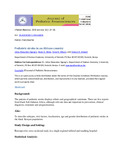Pediatric stroke in an African country

Date
2010-01Author
Ogeng'o, Julius A
Olabu, Beda O
Mburu, Anne N
Sinkeet, Simeon R
Type
ArticleLanguage
enMetadata
Show full item recordAbstract
Background:
The pattern of pediatric stroke displays ethnic and geographical variations. There are few reports from black Sub-Saharan Africa, although relevant data are important in prevention, clinical diagnosis, treatment and prognostication.
Aim:
To describe subtypes, risk factors, localization, age and gender distribution of pediatric stroke in the black Kenyan population.
Study Design and Setting:
Retrospective cross-sectional study in a single regional referral and teaching hospital.
Statistical Analysis:
Data were analyzed by SPSS version 13.0 for Windows and presented in tables and bar and pie charts.
Materials and Methods:
The study was performed at the Kenyatta National Hospital, a level-6 regional referral health facility with an annual pediatric in-patient turnover of about 40,000 patients. Files of patients aged 1 month to 18 years over a period of 5 years were analyzed for stroke subtypes, localization, risk factors, age and sex distribution. Only those files with complete information were included.
Results:
Thirty-two of the 712 stroke patients (4.5%) were pediatric. The male:female ratio was 1.7:1. Ischemic stroke comprised 56.3% (n = 18). Mean age was 7.7 years (range, 1.5–18 years). The most common sites were cortical (51%), lacunar (41%) and brain stem (8%). The most common risk factors were connective tissue disorders (28.1%), heart disease (25%), human immunodeficiency virus (9.4%) and infection (9.4%).
Conclusion:
Pediatric stroke is not uncommon in the Kenyan population. The risk factor profile comprising connective tissue disorders and infection differs from that reported in other populations, inviting large community-based studies.
URI
http://erepository.uonbi.ac.ke:8080/xmlui/handle/123456789/23364http://www.ncbi.nlm.nih.gov/pubmed/21042501
Citation
J Pediatr Neurosci. 2010 Jan-Jun; 5(1): 22–24.Publisher
Department of Human Anatomy
Collections
- Faculty of Health Sciences (FHS) [10378]
